GA-Net: Accurate and Efficient Object Detection on UAV Images Based on Grid Activations
Abstract
:1. Introduction
2. Related Works
2.1. Multiscale Feature Fusion
2.2. Focus on Important Regions
2.3. Coarse-to-Fine Framework
3. Methods
3.1. Overview
3.2. Grid Activation Module
3.2.1. Network Architecture
3.2.2. Details in Training
3.2.3. Details in Inference
| Inference Pseudocode. |
| Input: Original image (I) Detected_Objects = [] for each cropped_patch in the original image: F = extract_feature_map(cropped_patch) # use backbone A = calculate_grid_activations(F) binary_map = (A > threshold T) if binary_map contains any non-zero values: detection_result = detector(F) # use neck and head Detected_Objects.append(detection_result) else: Detected_Objects.append(empty_result) Output: Detected_Objects (bounding box coordinates, class labels, confidence scores) |
3.3. Grid-Based Dynamic Sample Selection
3.4. GhostFPN
4. Experimental Results and Analysis
4.1. Datasets and Evaluation Metrics
- DGTA-Cattle-v2
- VisDrone-vehicle
- SeaDronesSee
- DOTA-vehicle
- Metrics
4.2. Implementation Details
4.3. Comparative Experimental Results and Analysis
4.3.1. DGTA-Cattle-v2
4.3.2. VisDrone-Vehicle
4.3.3. SeaDronesSee
4.3.4. DOTA-Vehicle
4.4. Ablation Study
4.4.1. Comparison with the Baseline Model
- The modification of FPN to GhostFPN leads to improved detection metrics. This change reduces params by 16.68%, as well as decreased GFLOPs from 52.28 to 49.57, which showcases the efficiency in lightweighting the model. We also note improvements in mAP and AP50 by 1.6% and 2.1%, respectively. Additionally, the FPS slightly increases by 1.42%.
- The incorporation of the GAM slightly increases memory usage and GFLOPs. However, when coupled with GhostFPN, these metrics remain lower than those of the base detector. Without GDSS in training, just by removing the background patches predicted by the GAM, the accuracy can still be slightly improved by 0.7% in mAP and 0.3% in AP50 based on the modification of FPN to GhostFPN. Notably, the speed receives a boost of 56.97%, attributed to the coarse filtering before the refined detection process.
- The use of the GDSS strategy in training directs the model’s attention towards foreground areas, contributing to the additional 1.9% increase in performance, building upon all the other proposed modifications. Furthermore, under the mutual influence of multi-task learning, the GAM can filter foreground patches more accurately, leading to a further improvement in inference speed, surpassing the base detector by 71%.
4.4.2. Effect of the GAM on Two-Stage Models
5. Discussions and Conclusions
Author Contributions
Funding
Data Availability Statement
Conflicts of Interest
References
- Hayat, S.; Yanmaz, E.; Muzaffar, R. Survey on Unmanned Aerial Vehicle Networks for Civil Applications: A Communications Viewpoint. IEEE Commun. Surv. Tutor. 2016, 18, 2624–2661. [Google Scholar] [CrossRef]
- Nex, F.; Armenakis, C.; Cramer, M.; Cucci, D.A.; Gerke, M.; Honkavaara, E.; Kukko, A.; Persello, C.; Skaloud, J. UAV in the Advent of the Twenties: Where We Stand and What Is Next. ISPRS J. Photogramm. Remote Sens. 2022, 184, 215–242. [Google Scholar] [CrossRef]
- Byun, S.; Shin, I.-K.; Moon, J.; Kang, J.; Choi, S.-I. Road Traffic Monitoring from UAV Images Using Deep Learning Networks. Remote Sens. 2021, 13, 4027. [Google Scholar] [CrossRef]
- Abdelfattah, R.; Wang, X.; Wang, S. TTPLA: An Aerial-Image Dataset for Detection and Segmentation of Transmission Towers and Power Lines. In Computer Vision–ACCV 2020; Ishikawa, H., Liu, C.-L., Pajdla, T., Shi, J., Eds.; Lecture Notes in Computer Science; Springer International Publishing: Cham, Switzerland, 2021; Volume 12627, pp. 601–618. ISBN 978-3-030-69543-9. [Google Scholar]
- Osco, L.P.; dos Santos de Arruda, M.; Gonçalves, D.N.; Dias, A.; Batistoti, J.; de Souza, M.; Gomes, F.D.G.; Ramos, A.P.M.; de Castro Jorge, L.A.; Liesenberg, V.; et al. A CNN Approach to Simultaneously Count Plants and Detect Plantation-Rows from UAV Imagery. ISPRS J. Photogramm. Remote Sens. 2021, 174, 1–17. [Google Scholar] [CrossRef]
- Huang, Z.; Chen, C.; Pan, M. Multiobjective UAV Path Planning for Emergency Information Collection and Transmission. IEEE Internet Things J. 2020, 7, 6993–7009. [Google Scholar] [CrossRef]
- Alsamhi, S.H.; Shvetsov, A.V.; Kumar, S.; Shvetsova, S.V.; Alhartomi, M.A.; Hawbani, A.; Rajput, N.S.; Srivastava, S.; Saif, A.; Nyangaresi, V.O. UAV Computing-Assisted Search and Rescue Mission Framework for Disaster and Harsh Environment Mitigation. Drones 2022, 6, 154. [Google Scholar] [CrossRef]
- Božić-Štulić, D.; Marušić, Ž.; Gotovac, S. Deep Learning Approach in Aerial Imagery for Supporting Land Search and Rescue Missions. Int. J. Comput. Vis. 2019, 127, 1256–1278. [Google Scholar] [CrossRef]
- Ren, S.; He, K.; Girshick, R.; Sun, J. Faster R-CNN: Towards Real-Time Object Detection with Region Proposal Networks. IEEE Trans. Pattern Anal. Mach. Intell. 2017, 39, 1137–1149. [Google Scholar] [CrossRef] [PubMed]
- Redmon, J.; Divvala, S.; Girshick, R.; Farhadi, A. You Only Look Once: Unified, Real-Time Object Detection. In Proceedings of the 2016 IEEE Conference on Computer Vision and Pattern Recognition (CVPR), Las Vegas, NV, USA, 27–30 June 2016; IEEE: Las Vegas, NV, USA, 2016; pp. 779–788. [Google Scholar]
- Lin, T.-Y.; Goyal, P.; Girshick, R.; He, K.; Dollár, P. Focal Loss for Dense Object Detection. IEEE Trans. Pattern Anal. Mach. Intell. 2020, 42, 318–327. [Google Scholar] [CrossRef]
- Dosovitskiy, A.; Beyer, L.; Kolesnikov, A.; Weissenborn, D.; Zhai, X.; Unterthiner, T.; Dehghani, M.; Minderer, M.; Heigold, G.; Gelly, S.; et al. An Image is Worth 16x16 Words: Transformers for Image Recognition at Scale. In Proceedings of the ICLR 2021, Virtual, 3–7 May 2021. [Google Scholar]
- Everingham, M.; Van Gool, L.; Williams, C.K.I.; Winn, J.; Zisserman, A. The Pascal Visual Object Classes (VOC) Challenge. Int. J. Comput. Vis. 2010, 88, 303–338. [Google Scholar] [CrossRef]
- Lin, T.-Y.; Maire, M.; Belongie, S.; Hays, J.; Perona, P.; Ramanan, D.; Dollár, P.; Zitnick, C.L. Microsoft COCO: Common Objects in Context. In Proceedings of the Computer Vision–ECCV 2014, Zurich, Switzerland, 6–12 September 2014; Fleet, D., Pajdla, T., Schiele, B., Tuytelaars, T., Eds.; Springer International Publishing: Cham, Switzerland, 2014; pp. 740–755. [Google Scholar]
- Lin, M.; Chen, Q.; Yan, S. Network in Network. Available online: https://arxiv.org/abs/1312.4400v3 (accessed on 7 January 2024).
- Unel, F.O.; Ozkalayci, B.O.; Cigla, C. The Power of Tiling for Small Object Detection. In Proceedings of the 2019 IEEE/CVF Conference on Computer Vision and Pattern Recognition Workshops (CVPRW), Long Beach, CA, USA, 16–17 June 2019; pp. 582–591. [Google Scholar]
- Varga, L.A.; Zell, A. Tackling the Background Bias in Sparse Object Detection via Cropped Windows. In Proceedings of the 2021 IEEE/CVF International Conference on Computer Vision Workshops (ICCVW), Montreal, BC, Canada, 11–17 October 2021; pp. 2768–2777. [Google Scholar]
- Pang, J.; Li, C.; Shi, J.; Xu, Z.; Feng, H. R2-CNN: Fast Tiny Object Detection in Large-Scale Remote Sensing Images. IEEE Trans. Geosci. Remote Sens. 2019, 57, 5512–5524. [Google Scholar] [CrossRef]
- Yang, F.; Fan, H.; Chu, P.; Blasch, E.; Ling, H. Clustered Object Detection in Aerial Images. In Proceedings of the 2019 IEEE/CVF International Conference on Computer Vision (ICCV), Seoul, Republic of Korea, 27 October–2 November 2019; pp. 8310–8319. [Google Scholar]
- Wang, Y.; Yang, Y.; Zhao, X. Object Detection Using Clustering Algorithm Adaptive Searching Regions in Aerial Images. In Proceedings of the Computer Vision–ECCV 2020 Workshops, Glasgow, UK, 23–28 August 2020; Bartoli, A., Fusiello, A., Eds.; Springer International Publishing: Cham, Switzerland, 2020; pp. 651–664. [Google Scholar]
- Deng, S.; Li, S.; Xie, K.; Song, W.; Liao, X.; Hao, A.; Qin, H. A Global-Local Self-Adaptive Network for Drone-View Object Detection. IEEE Trans. Image Process. 2021, 30, 1556–1569. [Google Scholar] [CrossRef]
- Huang, Y.; Chen, J.; Huang, D. UFPMP-Det:Toward Accurate and Efficient Object Detection on Drone Imagery. Proc. AAAI Conf. Artif. Intell. 2022, 36, 1026–1033. [Google Scholar] [CrossRef]
- Xie, X.; Cheng, G.; Li, Q.; Miao, S.; Li, K.; Han, J. Fewer Is More: Efficient Object Detection in Large Aerial Images. Sci. China Inf. Sci. 2024, 67, 112106. [Google Scholar] [CrossRef]
- Han, K.; Wang, Y.; Tian, Q.; Guo, J.; Xu, C.; Xu, C. GhostNet: More Features from Cheap Operations. In Proceedings of the 2020 IEEE/CVF Conference on Computer Vision and Pattern Recognition (CVPR), Seattle, WA, USA, 14–19 June 2020; pp. 1577–1586. [Google Scholar]
- Lin, T.-Y.; Dollar, P.; Girshick, R.; He, K.; Hariharan, B.; Belongie, S. Feature Pyramid Networks for Object Detection. In Proceedings of the 2017 IEEE Conference on Computer Vision and Pattern Recognition (CVPR), Honolulu, HI, USA, 21–26 July 2017; pp. 936–944. [Google Scholar]
- Kiefer, B.; Ott, D.; Zell, A. Leveraging Synthetic Data in Object Detection on Unmanned Aerial Vehicles. In Proceedings of the 2022 26th International Conference on Pattern Recognition (ICPR), Montreal, QC, Canada, 21–25 August 2022; pp. 3564–3571. [Google Scholar]
- Yang, X.; Sun, H.; Fu, K.; Yang, J.; Sun, X.; Yan, M.; Guo, Z. Automatic Ship Detection in Remote Sensing Images from Google Earth of Complex Scenes Based on Multiscale Rotation Dense Feature Pyramid Networks. Remote Sens. 2018, 10, 132. [Google Scholar] [CrossRef]
- Wang, J.; Ding, J.; Guo, H.; Cheng, W.; Pan, T.; Yang, W. Mask OBB: A Semantic Attention-Based Mask Oriented Bounding Box Representation for Multi-Category Object Detection in Aerial Images. Remote Sens. 2019, 11, 2930. [Google Scholar] [CrossRef]
- Liu, Y.; Yang, F.; Hu, P. Small-Object Detection in UAV-Captured Images via Multi-Branch Parallel Feature Pyramid Networks. IEEE Access 2020, 8, 145740–145750. [Google Scholar] [CrossRef]
- Amudhan, A.N.; Sudheer, A.P. Lightweight and Computationally Faster Hypermetropic Convolutional Neural Network for Small Size Object Detection. Image Vis. Comput. 2022, 119, 104396. [Google Scholar] [CrossRef]
- Li, B.; Liu, Y.; Wang, X. Gradient Harmonized Single-Stage Detector. Proc. AAAI Conf. Artif. Intell. 2019, 33, 8577–8584. [Google Scholar] [CrossRef]
- Shrivastava, A.; Gupta, A.; Girshick, R. Training Region-Based Object Detectors with Online Hard Example Mining. In Proceedings of the 2016 IEEE Conference on Computer Vision and Pattern Recognition (CVPR), Las Vegas, NV, USA, 27–30 June 2016; pp. 761–769. [Google Scholar]
- Zhang, S.; Chi, C.; Yao, Y.; Lei, Z.; Li, S.Z. Bridging the Gap Between Anchor-Based and Anchor-Free Detection via Adaptive Training Sample Selection. In Proceedings of the 2020 IEEE/CVF Conference on Computer Vision and Pattern Recognition (CVPR), Seattle, WA, USA, 14–19 June 2020; pp. 9756–9765. [Google Scholar]
- Kim, K.; Lee, H.S. Probabilistic Anchor Assignment with IoU Prediction for Object Detection. In Proceedings of the Computer Vision–ECCV 2020, Glasgow, UK, 23–28 August 2020; Vedaldi, A., Bischof, H., Brox, T., Frahm, J.-M., Eds.; Springer International Publishing: Cham, Switzerland, 2020; pp. 355–371. [Google Scholar]
- Zhu, B.; Wang, J.; Jiang, Z.; Zong, F.; Liu, S.; Li, Z.; Sun, J. AutoAssign: Differentiable Label Assignment for Dense Object Detection 2020. Available online: http://arxiv.org/abs/2007.03496 (accessed on 7 January 2024).
- Zhang, J.; Huang, J.; Chen, X.; Zhang, D. How to Fully Exploit the Abilities of Aerial Image Detectors. In Proceedings of the 2019 IEEE/CVF International Conference on Computer Vision Workshop (ICCVW), Seoul, Republic of Korea, 27–28 October 2019; pp. 1–8. [Google Scholar]
- Yu, Z.; Luo, W.; Tse, R.; Pau, G. DMNet: A Personalized Risk Assessment Framework for Elderly People with Type 2 Diabetes. IEEE J. Biomed. Health Inform. 2023, 27, 1558–1568. [Google Scholar] [CrossRef]
- Beck, E.; Bockelmann, C.; Dekorsy, A. CMDNet: Learning a Probabilistic Relaxation of Discrete Variables for Soft Detection with Low Complexity. IEEE Trans. Commun. 2021, 69, 8214–8227. [Google Scholar] [CrossRef]
- Leng, J.; Mo, M.; Zhou, Y.; Gao, C.; Li, W.; Gao, X. Pareto Refocusing for Drone-View Object Detection. IEEE Trans. Circuits Syst. Video Technol. 2023, 33, 1320–1334. [Google Scholar] [CrossRef]
- Xu, J.; Li, Y.; Wang, S. AdaZoom: Adaptive Zoom Network for Multi-Scale Object Detection in Large Scenes 2021. Available online: http://arxiv.org/abs/2106.10409 (accessed on 7 January 2024).
- Uzkent, B.; Yeh, C.; Ermon, S. Efficient Object Detection in Large Images Using Deep Reinforcement Learning. In Proceedings of the 2020 IEEE Winter Conference on Applications of Computer Vision (WACV), Snowmass Village, CO, USA, 1–5 March 2020; pp. 1813–1822. [Google Scholar]
- Chollet, F. Xception: Deep Learning with Depthwise Separable Convolutions. In Proceedings of the 2017 IEEE Conference on Computer Vision and Pattern Recognition (CVPR), Honolulu, HI, USA, 21–26 July 2017; pp. 1800–1807. [Google Scholar]
- He, K.; Zhang, X.; Ren, S.; Sun, J. Deep Residual Learning for Image Recognition. In Proceedings of the 2016 IEEE Conference on Computer Vision and Pattern Recognition (CVPR), Las Vegas, NV, USA, 27–30 June 2016; pp. 770–778. [Google Scholar]
- Xie, S.; Girshick, R.; Dollar, P.; Tu, Z.; He, K. Aggregated Residual Transformations for Deep Neural Networks. In Proceedings of the 2017 IEEE Conference on Computer Vision and Pattern Recognition (CVPR), Honolulu, HI, USA, 21–26 July 2017; pp. 5987–5995. [Google Scholar]
- Howard, A.; Sandler, M.; Chen, B.; Wang, W.; Chen, L.-C.; Tan, M.; Chu, G.; Vasudevan, V.; Zhu, Y.; Pang, R.; et al. Searching for MobileNetV3. In Proceedings of the 2019 IEEE/CVF International Conference on Computer Vision (ICCV), Seoul, Republic of Korea, 27 October–2 November 2019; pp. 1314–1324. [Google Scholar]
- Ma, N.; Zhang, X.; Zheng, H.-T.; Sun, J. ShuffleNet V2: Practical Guidelines for Efficient CNN Architecture Design. In Proceedings of the Computer Vision–ECCV 2018, Munich, Germany, 8–14 September 2018; Ferrari, V., Hebert, M., Sminchisescu, C., Weiss, Y., Eds.; Lecture Notes in Computer Science. Springer International Publishing: Cham, Switzerland, 2018; Volume 11218, pp. 122–138, ISBN 978-3-030-01263-2. [Google Scholar]
- Cao, Y.; He, Z.; Wang, L.; Wang, W.; Yuan, Y.; Zhang, D.; Zhang, J.; Zhu, P.; Van Gool, L.; Han, J.; et al. VisDrone-DET2021: The vision meets drone object detection challenge results. In Proceedings of the IEEE/CVF International Conference on Computer Vision, Nashville, TN, USA, 20–25 June 2021; pp. 2847–2854. [Google Scholar]
- Varga, L.A.; Kiefer, B.; Messmer, M.; Zell, A. SeaDronesSee: A Maritime Benchmark for Detecting Humans in Open Water. In Proceedings of the 2022 IEEE/CVF Winter Conference on Applications of Computer Vision (WACV), Waikoloa, HI, USA, 3–8 January 2022; pp. 3686–3696. [Google Scholar]
- Ding, J.; Xue, N.; Xia, G.-S.; Bai, X.; Yang, W.; Yang, M.Y.; Belongie, S.; Luo, J.; Datcu, M.; Pelillo, M.; et al. Object Detection in Aerial Images: A Large-Scale Benchmark and Challenges. IEEE Trans. Pattern Anal. Mach. Intell. 2022, 44, 7778–7796. [Google Scholar] [CrossRef] [PubMed]
- Cai, Z.; Vasconcelos, N. Cascade R-CNN: High Quality Object Detection and Instance Segmentation. IEEE Trans. Pattern Anal. Mach. Intell. 2021, 43, 1483–1498. [Google Scholar] [CrossRef]
- Tian, Z.; Shen, C.; Chen, H.; He, T. FCOS: Fully Convolutional One-Stage Object Detection. In Proceedings of the 2019 IEEE/CVF International Conference on Computer Vision (ICCV), Seoul, Republic of Korea, 27 October–2 November 2019; pp. 9626–9635. [Google Scholar]
- Duan, K.; Bai, S.; Xie, L.; Qi, H.; Huang, Q.; Tian, Q. CenterNet: Keypoint Triplets for Object Detection. In Proceedings of the 2019 IEEE/CVF International Conference on Computer Vision (ICCV), Seoul, Republic of Korea, 27 October–2 November 2019; pp. 6568–6577. [Google Scholar]
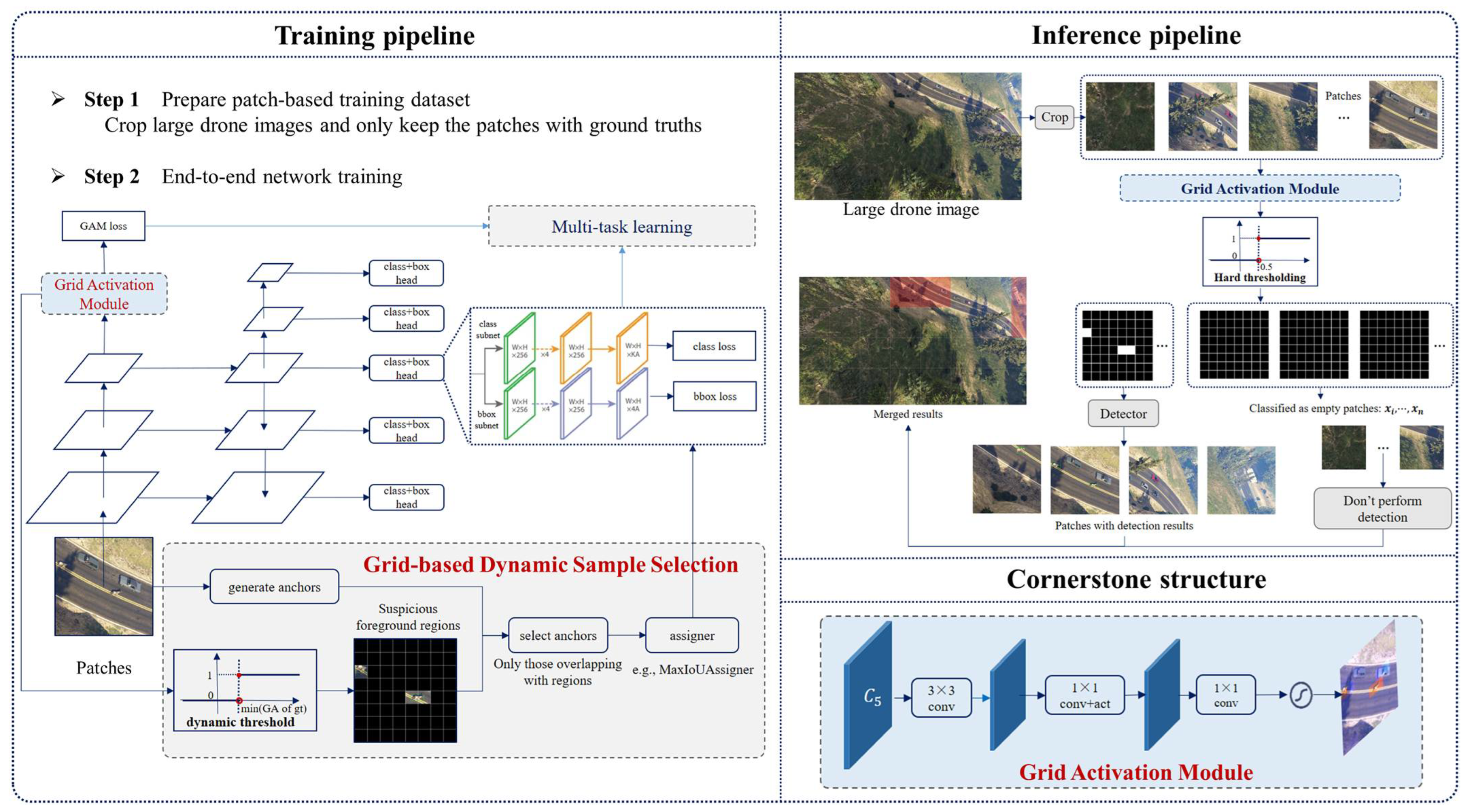



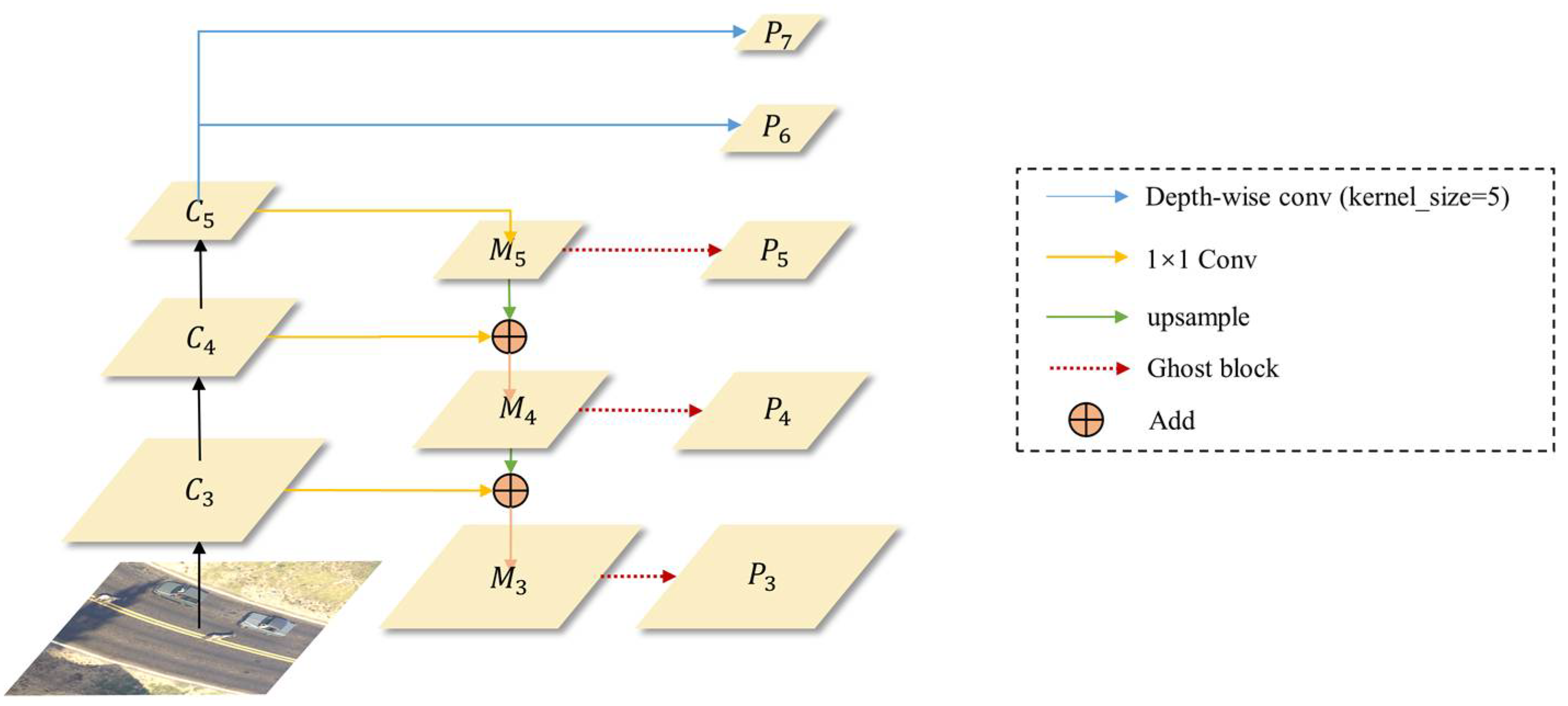





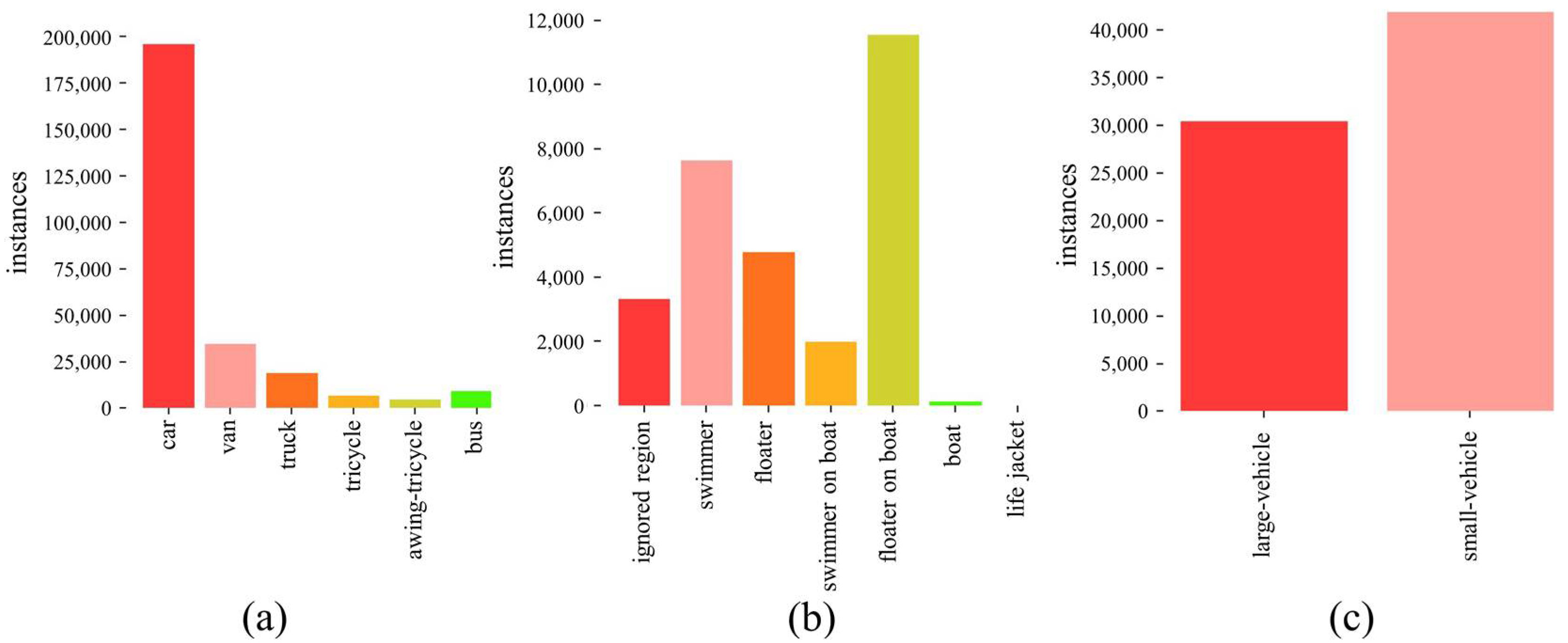




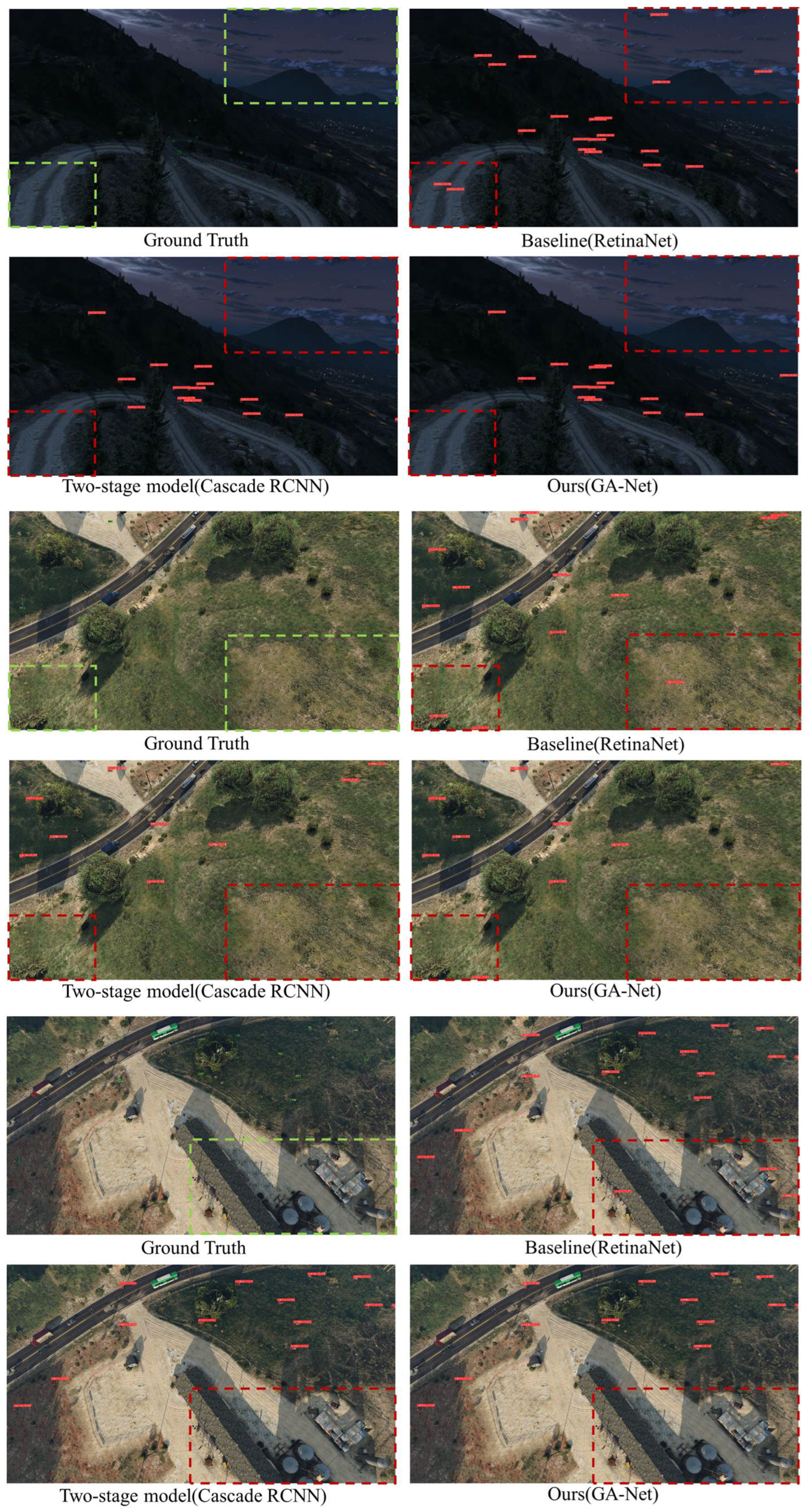



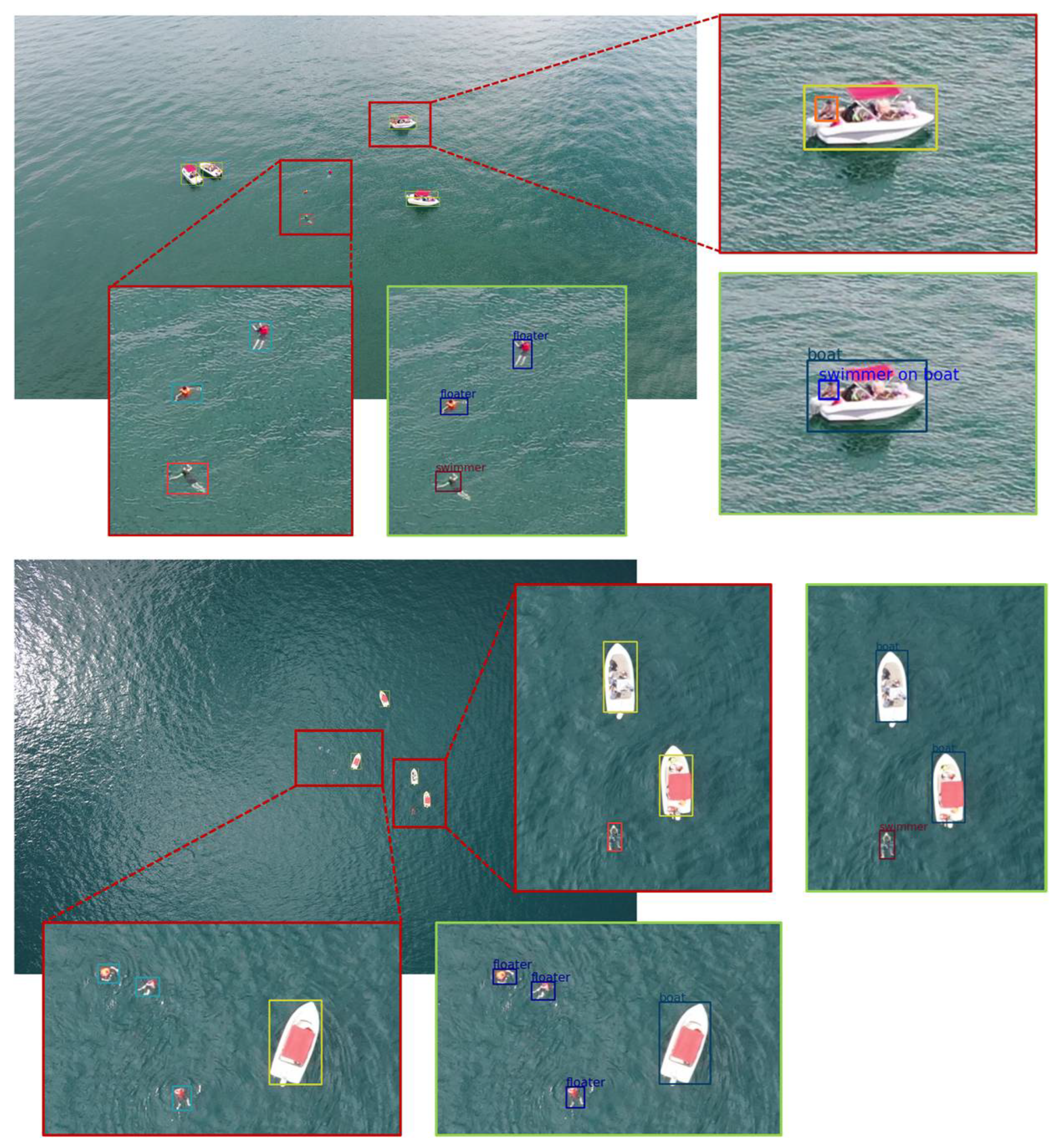
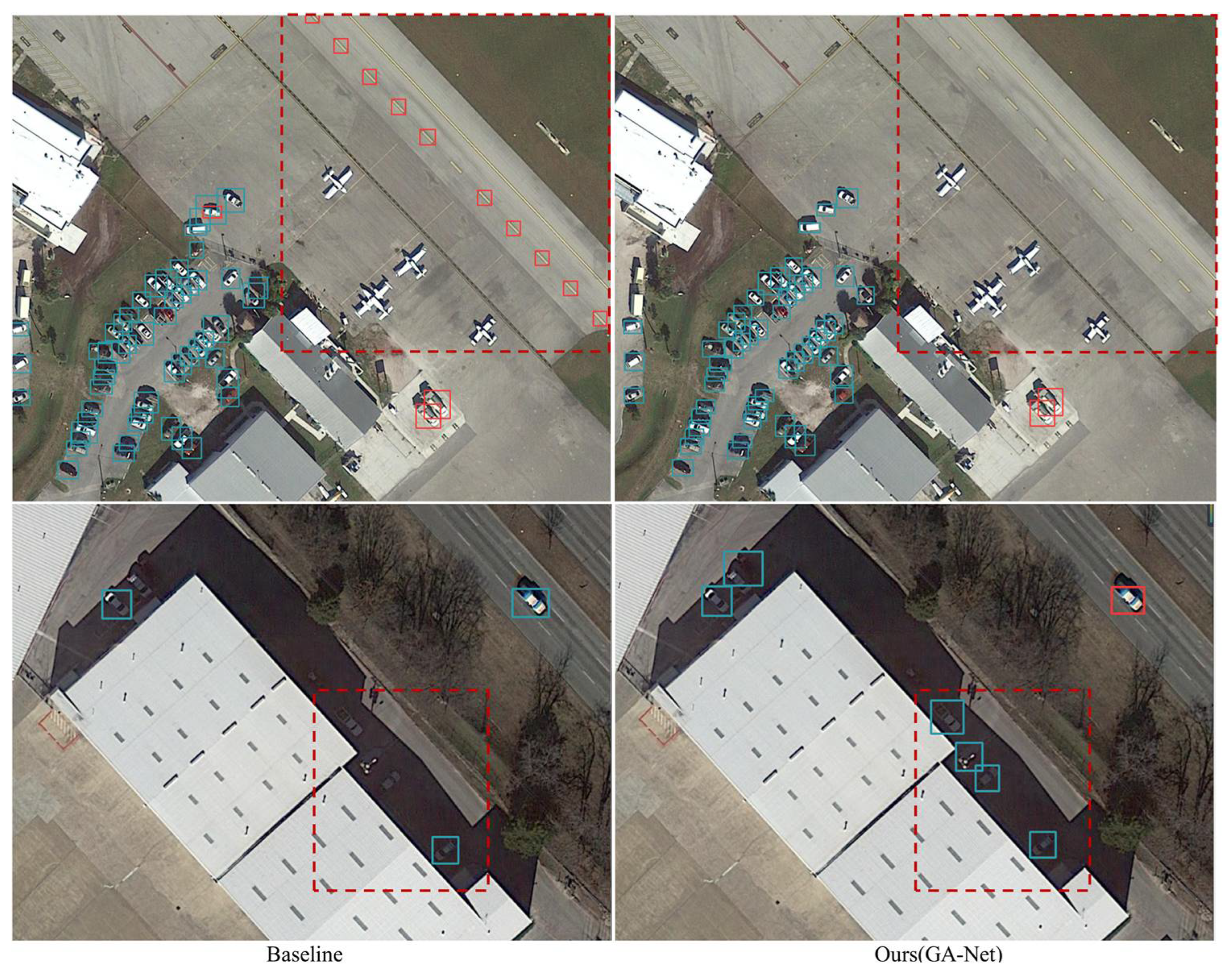
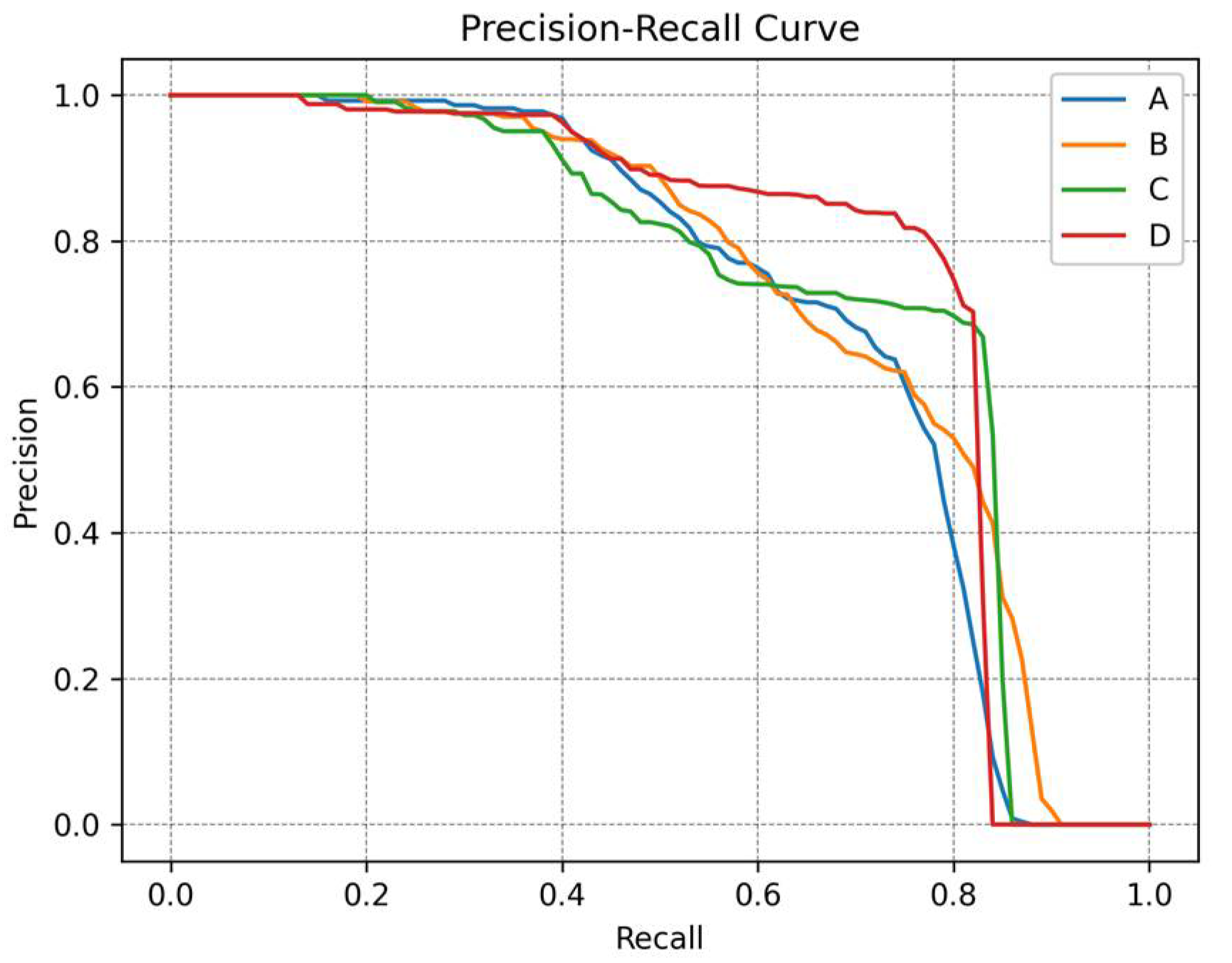
| Name | Domain | Data Type | Image Width | Contain Background Images or Not |
|---|---|---|---|---|
| DGTA-Cattle-v2 | agriculture | synthetic | 3840 | Yes |
| VisDrone-vehicle | traffic | real | 960–2000 | No |
| SeaDronesSee | maritime | real | 3840–5456 | No |
| DOTA-vehicle | urban | real | 800–20,000 | No |
| Type | Model | Feature Pyramid | mAP50:95 | GFLOPs | Params | FPS |
|---|---|---|---|---|---|---|
| Two-stage | Faster RCNN | FPN | 0.463 | 63.25 | 41.12 | 0.884 |
| Cascade RCNN | FPN | 0.476 | 91.05 | 68.93 | 0.734 | |
| One-stage | FCOS | FPN | 0.388 | 51.80 | 36.02 | 1.153 |
| CenterNet | CTResNetNeck | 0.363 | 25.97 | 29.86 | 1.731 | |
| ATSS | FPN | 0.420 | 51.54 | 31.89 | 1.141 | |
| YOLOv8 1 | YOLOv8 Neck | 0.447 | 50.60 | 25.86 | 1.794 | |
| RetinaNet (Baseline) | FPN | 0.411 | 52.28 | 36.10 | 1.125 | |
| GA-Net (Ours) | GhostFPN | 0.453 | 49.72 | 32.48 | 1.928 |
| Type | Model | Feature Pyramid | mAP50:95 | GFLOPs | Params | FPS |
|---|---|---|---|---|---|---|
| Two-stage | Faster RCNN | FPN | 0.255 | 26.26 | 41.15 | 6.34 |
| one-stage | RetinaNet | FPN | 0.223 | 13.21 | 36.21 | 8.55 |
| GA-Net (Ours) | GhostFPN | 0.247 | 12.57 | 32.58 | 10.89 |
| Type | Model | Feature Pyramid | mAP50:95 | GFLOPs | Params | FPS |
|---|---|---|---|---|---|---|
| Two-stage | Faster RCNN | FPN | 0.330 | 63.28 | 41.15 | 0.687 |
| One-stage | RetinaNet | FPN | 0.322 | 52.96 | 36.23 | 0.877 |
| GA-Net (Ours) | GhostFPN | 0.328 | 50.40 | 32.60 | 1.437 |
| Type | Model | Feature Pyramid | mAP50:95 | GFLOPs | Params | FPS |
|---|---|---|---|---|---|---|
| Two-stage | Faster RCNN | FPN | 0.413 | 211.29 | 41.13 | 3.83 |
| One-stage | RetinaNet | FPN | 0.356 | 209.58 | 36.13 | 4.84 |
| GA-Net (Ours) | GhostFPN | 0.394 | 199.33 | 32.50 | 6.44 |
| Method | GAM | Feature Pyramid | GDSS | mAP50:95 | mAP50 | GFLOPs | Params | FPS |
|---|---|---|---|---|---|---|---|---|
| A | × | FPN | × | 0.411 | 0.706 | 52.28 | 36.10 | 1.125 |
| B | × | GhostFPN | × | 0.427 | 0.727 | 49.57 | 30.08 | 1.141 |
| C | √ | GhostFPN | × | 0.434 | 0.730 | 49.72 | 32.48 | 1.791 |
| D | √ | GhostFPN | √ | 0.453 | 0.745 | 49.72 | 32.48 | 1.928 |
| Method | GAM | mAP50:95 | mAP50 | FPS |
|---|---|---|---|---|
| Faster RCNN | × | 0.423 | 0.538 | 3.83 |
| Faster RCNN | √ | 0.428 | 0.544 | 4.71 |
| Method | GAM | mAP50:95 | mAP50 | FPS |
|---|---|---|---|---|
| Faster RCNN | × | 0.255 | 0.407 | 6.34 |
| Faster RCNN | √ | 0.260 | 0.431 | 8.94 |
Disclaimer/Publisher’s Note: The statements, opinions and data contained in all publications are solely those of the individual author(s) and contributor(s) and not of MDPI and/or the editor(s). MDPI and/or the editor(s) disclaim responsibility for any injury to people or property resulting from any ideas, methods, instructions or products referred to in the content. |
© 2024 by the authors. Licensee MDPI, Basel, Switzerland. This article is an open access article distributed under the terms and conditions of the Creative Commons Attribution (CC BY) license (https://creativecommons.org/licenses/by/4.0/).
Share and Cite
Zhang, R.; Luo, B.; Su, X.; Liu, J. GA-Net: Accurate and Efficient Object Detection on UAV Images Based on Grid Activations. Drones 2024, 8, 74. https://doi.org/10.3390/drones8030074
Zhang R, Luo B, Su X, Liu J. GA-Net: Accurate and Efficient Object Detection on UAV Images Based on Grid Activations. Drones. 2024; 8(3):74. https://doi.org/10.3390/drones8030074
Chicago/Turabian StyleZhang, Ruiyi, Bin Luo, Xin Su, and Jun Liu. 2024. "GA-Net: Accurate and Efficient Object Detection on UAV Images Based on Grid Activations" Drones 8, no. 3: 74. https://doi.org/10.3390/drones8030074
APA StyleZhang, R., Luo, B., Su, X., & Liu, J. (2024). GA-Net: Accurate and Efficient Object Detection on UAV Images Based on Grid Activations. Drones, 8(3), 74. https://doi.org/10.3390/drones8030074






